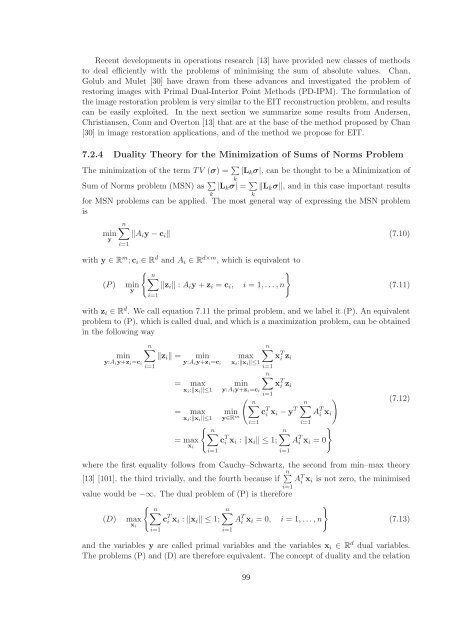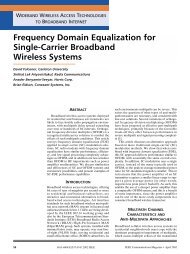Image Reconstruction for 3D Lung Imaging - Department of Systems ...
Image Reconstruction for 3D Lung Imaging - Department of Systems ...
Image Reconstruction for 3D Lung Imaging - Department of Systems ...
You also want an ePaper? Increase the reach of your titles
YUMPU automatically turns print PDFs into web optimized ePapers that Google loves.
Recent developments in operations research [13] have provided new classes <strong>of</strong> methods<br />
to deal efficiently with the problems <strong>of</strong> minimising the sum <strong>of</strong> absolute values. Chan,<br />
Golub and Mulet [30] have drawn from these advances and investigated the problem <strong>of</strong><br />
restoring images with Primal Dual-Interior Point Methods (PD-IPM). The <strong>for</strong>mulation <strong>of</strong><br />
the image restoration problem is very similar to the EIT reconstruction problem, and results<br />
can be easily exploited. In the next section we summarize some results from Andersen,<br />
Christiansen, Conn and Overton [13] that are at the base <strong>of</strong> the method proposed by Chan<br />
[30] in image restoration applications, and <strong>of</strong> the method we propose <strong>for</strong> EIT.<br />
7.2.4 Duality Theory <strong>for</strong> the Minimization <strong>of</strong> Sums <strong>of</strong> Norms Problem<br />
The minimization <strong>of</strong> the term TV (σ) = �<br />
|Lkσ|, can be thought to be a Minimization <strong>of</strong><br />
k<br />
Sum <strong>of</strong> Norms problem (MSN) as �<br />
|Lkσ| = �<br />
�Lkσ�, and in this case important results<br />
k<br />
<strong>for</strong> MSN problems can be applied. The most general way <strong>of</strong> expressing the MSN problem<br />
is<br />
min<br />
y<br />
k<br />
n�<br />
�Aiy − ci� (7.10)<br />
i=1<br />
with y ∈ Rm ;ci ∈ Rd and Ai ∈ Rd×m , which is equivalent to<br />
�<br />
n�<br />
�<br />
(P) min<br />
y<br />
�zi� : Aiy + zi = ci, i = 1,... ,n<br />
i=1<br />
(7.11)<br />
with zi ∈ R d . We call equation 7.11 the primal problem, and we label it (P). An equivalent<br />
problem to (P), which is called dual, and which is a maximization problem, can be obtained<br />
in the following way<br />
min<br />
y:Aiy+zi=ci<br />
n�<br />
i=1<br />
�zi� = min<br />
y:Aiy+zi=ci<br />
= max<br />
xi:�xi�≤1<br />
max<br />
xi:�xi�≤1<br />
min<br />
y:Aiy+zi=ci<br />
�<br />
n�<br />
= max<br />
xi:�xi�≤1 min<br />
y∈Rm �<br />
n�<br />
= max<br />
xi<br />
i=1<br />
i=1<br />
n�<br />
i=1<br />
n�<br />
i=1<br />
c T i xi : �xi� ≤ 1;<br />
x T i zi<br />
x T i zi<br />
c T i xi − y T<br />
n�<br />
i=1<br />
n�<br />
i=1<br />
A T i xi<br />
A T i xi = 0<br />
�<br />
�<br />
(7.12)<br />
where the first equality follows from Cauchy–Schwartz, the second from min–max theory<br />
[13] [101], the third trivially, and the fourth because if n�<br />
AT i xi is not zero, the minimised<br />
value would be −∞. The dual problem <strong>of</strong> (P) is there<strong>for</strong>e<br />
�<br />
n�<br />
(D) max c<br />
xi<br />
T n�<br />
i xi : �xi� ≤ 1;<br />
i=1<br />
i=1<br />
i=1<br />
A T i xi = 0, i = 1,... ,n<br />
�<br />
(7.13)<br />
and the variables y are called primal variables and the variables xi ∈ R d dual variables.<br />
The problems (P) and (D) are there<strong>for</strong>e equivalent. The concept <strong>of</strong> duality and the relation<br />
99





